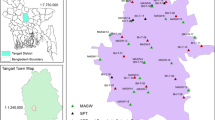Abstract
Geophysical characterization of the subsurface by shallow seismic and electrical resistivity in conjunction with the geological conditions can provide more realistic information on earthquake hazard vulnerability assessment. Earthquake hazard vulnerability assessment requires not only the knowledge of earthquake source and propagation of seismic waves, but also local geological conditions which regulate ground shaking. Geophysical methods such as shallow seismic, electrical tomography, borehole geophysics and microtremor response are the most effective tools those contribute substantially in the earthquake hazard microzoning program. Strong-motion ground shaking character of a site due to an earthquake depends firstly on the magnitude of the source (moment magnitude, Mw) and the focal depth. However, fault reactivation can develop strong ground shaking at a site. Similarly, ground liquefaction can occur due to wave attenuation and amplification and can develop long residence time for ground shaking. Hence, earthquake hazard vulnerability of a site can be addressed more realistically taking into consideration of the source response, path response and site response. Groundwater condition and lithological variation of the subsurface zone can play an important role on the seismic response of a site. Geophysical parameters such as electrical resistivity, shear-wave velocity, dominant period and amplification factor in conjunction with geological information provide earthquake hazard vulnerability status. Earthquake hazard zoning is the first and the most important required step toward seismic risk analysis and mitigation strategy in the densely populated urban areas. Major earthquakes such as Bengal Earthquake in 1885 (also known as Manikganj Earthquake), 1897 Great Indian Earthquake and 1918 Srimangal Earthquake affected Dhaka Mega City of Bangladesh significantly. These earthquakes have been considered as the scenario earthquakes for hazard vulnerability assessment of Dhaka Mega City.
















Similar content being viewed by others
References
Arnold C (2013) Earthquake effects on buildings. Chapter 4, Federal Emergency Management Agency, USA. www.fema.gov/…/fema454_ch…
Bolt BA (1978) Earthquakes: a primer. W. H. Freeman and Company, San Francisco
Davidson R (1997) A multidisciplinary urban earthquake disaster risk index. Earthq Spectra 13(2):211–223
Dobrin MB (1976) Introduction to geophysical prospecting, 3rd edn. McGraw Hill, New York 630p
Hunt RE (2007) Geologic hazards: a field guide for geotechnical engineers. Taylor & Francis Group, Boca Raton 323p
Huntec Geology and Geophysics (1981) Report of an aeromagnetic survey of Bangladesh. Geological Survey of Bangladesh, Govt. of Bangladesh 25 p
Idriss IM (1991) Earthquake ground motions at soft soil sites. In: Proceedings of the 2nd international conference on recent advances in geotechnical earthquake engineering and soil dynamics Vol. III: 2265–2271
ITC, Faculty of Geo-Information Science and Earth Observation at the University of Twente, The Netherlands. www.itc.nl
Khan AA (2010) Earthquake, tsunami and geology of Bangladesh. The University Grants Commission of Bangladesh, Dhaka. UGC Publication No.127, pp. 331
Khan AA, Hossain MS (2005) Recurrence of 1885 Bengal earthquake and hazard vulnerability status of Dhaka Metropolitan City, Bangladesh. Orient Geogr 49(2): 205–216. www.thedailystar.net
Khan AA, Akhter SH, Alam SMM (2000) Evidence of Holocene transgression, dolomitization and source of arsenic in the Bengal Delta. In: Mohamed AMO, Al Hosani KI (eds) Geoengineering in arid lands. Balkema, The Netherlands, pp 351–355
Kramer SL (1995) Geotechnical earthquake engineering. Prentice Hall, Upper Saddle River 653p
Medlicott HB (1885) Preliminary notice of the Bengal Earthquake of 14th July 1885. Rec Geol Surv India XVIII part 3:156–158
Morgan JP, McIntire WG (1956) Quaternary geology of the Bengal basin, east Pakistan and India. Bull Geol Soc Am 70:319–342
Oldham RD (1899) Report of the great earthquake of 12 June 1897. Mem Geol Surv India 29:379
Oranc NZ (1990) Application of wave equation analysis to pile driving. Unpublished Thesis of Master of Science, The Middle East Technical University. <etd.lib.metu.edu.tr>
Rogers AM, Walsh TJ, Kockelman WJ, Priest GR (1996) Earthquake hazards in the Pacific Northwest—An overview. In: Rogers AM, Walsh TJ, Kockelman WJ, Priest GR (eds) Assessing earthquake hazards and reducing risk in the Pacific Northwest, v.1, U. S. Geol. Surv. Professional Paper 1560: 1–54
Seeber L, Armbruster AG, Quittmeyer J (1981) Seismicity and continental subduction in the Himalayan Arc. In: Gupta HK and Delany FM (eds) Zagros, Hindukush, Himalaya. Geodynamic Evolution, Geodynamics Series 3: 215–242
Seed HB, Schnabel PB (1972) Soil and geological effects on site response during earthquakes. In: Proceedings of first international conference on microzonation for safer construction–research and application vol. I, 61–74
Seed HB, Romo MP, Sun JI, Jaime A, Lysmer J (1988) The Mexico earthquake of September 19, 1985–Relationships between soil conditions and earthquake ground motions. Earthq Spectra EERI 4(4):687–729
Slob S, Hack R, Scarpas T, Bemmelen B, Duque A (2002) A methodology for seismic microzonation using GIS and shake—a case study from Armenia, Colombia. In: Proceedings of 9th congress of the international association for engineering geology and the environment. Durban, South Africa, pp 2843–2852. https://www.itc.nl/library/papers/arti_conf…/slob_hack.pdf
Stuart M (1919) Preliminary note on the Srimangal earthquake of July 8, 1918. Records of the Geological Survey of India. v. XLIX part 3: 173–189
Stuart M (1926) The Srimangal earthquake of 8th July 1918. Memoirs of the Geological Survey of India. v. XLVI, part 1: 1–70
Tuladhar R, Yamazaki F, Warnitchai P, Saita J (2004) Seismic microzonation of the greater Bangkok area using microtremor observations. Earthq Eng Struct Dynam 33:211–225
Yargici V (2003) Assessment of buried pipe line performance during the 1999 Duzce Earthquake. Unpublished Thesis of Master of Science, The Middle east Technical University. <etd.lib.metu.edu.tr>
Acknowledgments
University of Malaya Research Grant (UMRG) RP002A-13AFR is duly acknowledged in conducting this research. Author also gratefully acknowledges Department of Geology of Dhaka University for the help and support provided. Reviewers are gratefully acknowledged for their valuable comments.
Author information
Authors and Affiliations
Corresponding author
Rights and permissions
About this article
Cite this article
Khan, A.A. Geophysical characterization and earthquake hazard vulnerability of Dhaka Mega City, Bangladesh, vis-à-vis impact of scenario earthquakes. Nat Hazards 82, 1147–1166 (2016). https://doi.org/10.1007/s11069-016-2237-9
Received:
Accepted:
Published:
Issue Date:
DOI: https://doi.org/10.1007/s11069-016-2237-9




